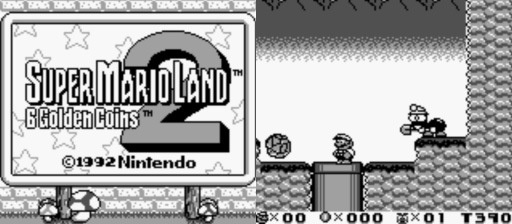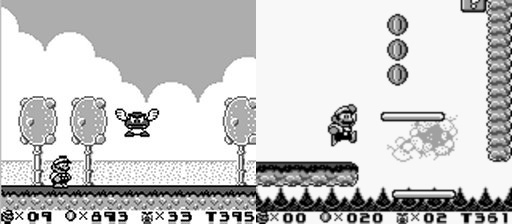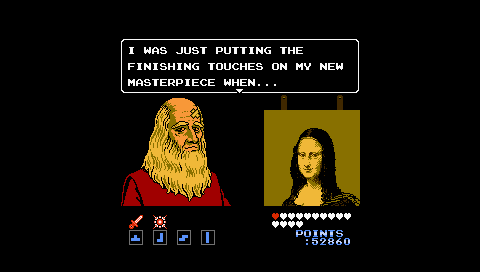Startropics and Other Recent Business
October 21st, 2016
A few months ago I played through Startropics with my friends over at the VG Commune. We recorded a couple of podcasts together and I also wrote up a rough photo diary of the two Startropics games. In the first podcast we discuss static and dynamic gameplay mechanics and how the grid-based gameplay makes the game very clean. In the second podcast we zoom out from the minute-to-minute gameplay and observe the flow between the game’s chapters. I thoroughly enjoyed the discussion and I’m sure you will too. The photo diaries are a bit rough, but I think they’re worth sharing as well.
This isn’t the first time that I’ve podcasted with the VG Commune. We’ve previously discussed Super Mario Land 2 levels, optional challenges in Wave Race 64, and the nature of two-dimensional space in The Firemen. Greg, aka Golem, has also been putting together videos out of some of our Super Mario Land 2 level discussions, so I’d urge you to check them out and follow him for more videos in the series. Although the DP blog is relatively quiet at the moment, I have been working away in the background over the past few months, so as always stay tuned. 🙂
R&D1: Deconstructing the Mario franchise on the Game Boy
August 1st, 2010
Portable game development has always acted as a test bed for experimental ideas. The handheld platforms are inexpensive to develop for and widely regarded as second-tier products to their console counterparts, making them the ideal haven for experimentation. Knowing this, R&D1, a technically-minded internal studio at Nintendo (now absorbed into Nintendo Software Planning & Development), used the newly released Game Boy as a way to expand the company’s most famous property: Mario. The design sensibilities and the innovations which evolved from the early Game Boy games Super Mario Land and Super Mario Land 2: 6 Golden Coins would find themselves not only canonized into franchise lore, but also playing a wide-reaching role in further developments of the series.
Super Mario Land
Prior to, and even since Super Mario Land‘s release in 1990, no other Mario title has modeled itself on real world cultures. Perhaps in a move to justify the “land” part of its title, Super Mario Landwas no longer set in the Mushroom Kingdom, but Sarasaland. Sarasaland was divided into 4 parts: an Egyptian-themed environment, an alien water world, ancient Aztec ruins and a Japanese oriental garden whose final act was set amongst the clouds. This was Super Mario Land‘s core conceit, and although no game in the series has since replicated world culture, Super Mario Landpaved the way for environments far removed from the realm and influence of the Mushroom Kingdom. Chocolate Island in Super Mario World, Yoshi’s Island in Super Mario World 2 and Isle Delfino in Super Mario Sunshine are good examples.
In relocating Mario outside of his stomping ground, R&D1 also replaced franchise staples: Bowser with Tatanga, Princess Peach with Princess Daisy and all familiar enemies – minus goombas – for stage-specific variants. Super Mario Land drove momentum for new and diverse enemies sets which could, at least for their respective titles, take a prominent role in the main cast. Princess Daisy has since been recognized in series cannon, playing a recurring role in the Mario sports andMario Kart series.
Not only did Super Mario Land go global and shed the Mushroom Kingdom attire, but the items and mechanics which remained were subversively tweaked and altered. Fireballs could now bounce off walls and surfaces, collecting coins in its wake. This lead to some cleverly designed puzzles as coins were often placed outside of Mario’s physical grasp. The end of level bonus was also reworked so that instead of being rewarded with a 1UP upon landing on top of a flagpole, players would have to navigate tricky platforms to reach a second floor which would prompt a small mini-game granting power-ups. The princess was still in another castle, however this time she was a facade whom would transform into one of Tatanga’s minions; one of the more obvious acts of tomfoolery. Further still, R&D1 undermined players with the koopa-esque bomb turtles who would detonate shortly after jumped upon. Nabbing a mushroom in mid-air would no longer cut Mario’s forward momentum. Not all of these tricks were intentional though, because of the Gameboy’s monotone graphics and Super Mario Land‘s tiny sprites, 1UP mushrooms were changed into hearts so that they could be easily discerned from power-ups. By tinkering with the player’s prior understanding of series norms, even minutely as some of the examples prove, Super Mario Land acknowledged a form of general trickery, and humor for long-time players which has permeated through most iterations of the series. Wriggler and Mecha-Bowsers in Super Mario World, Flower-head Shy Guys in Yoshi’s Island are further examples.
Totally new to Super Mario Land are the shoot-’em-up inspired levels where Mario mans a submarine (marine pop) or a plane (sky pop) to shoot down his enemies. The submarine level replaces the usual under water, swimming levels which are absent in this iteration. Even though these sections are tangential to the platforming, you can see elements of this design in Super Mario Sunshine and Super Mario Galaxy where other gameplay modes, such as pull stars, 2D gravity switching and manta ray surfing sequences are interspersed with the platforming.
Perhaps, above everything else though, Super Mario Land established portable design sensibilities.Super Mario Land wasn’t merely Mario on a portable console; it was a game designed for dedicated play in front of a TV adapted to the needs of playing on the go. This sense for quick, short bursts of play has been pivotal to many of Nintendo design sensibilities both in the console and handheld space. The star system in the 3D Mario games are examples of portability-minded design on a console, the “turning the machine on everyday” design of the Wii is another such example.
Super Mario Land 2: 6 Golden Coins
Super Mario Land 2 isn’t as radical as its predecessor, but it’s still pretty far removed. This time Mushroom Kingdom environments are mixed with properties of suburban reality. In many ways,Super Mario Land 2: 6 Golden Coins is reminiscent of the 1989 movie Honey, I Shrunk the Kids.Super Mario Land 2 is a slower-paced, exploratory platformer, so all of the sprites are enlarged which makes the world feel large and expansive. The overwhelming nature of the world works in combination with the assembly as household pests which populate the world alongside goombas and koopa troopas. This ordinary form of reality is revisited somewhat in Isle Delfino in Super Mario Sunshine and the Princess’ castle in Super Mario 64.
Two of the themed worlds deserve particular mention though. The first is the moon stage which would arguably foreshadow the release of Super Mario Galaxy. The second is the bizarre toy Mario level. An obvious piece of self-reference in the series at the time, later preceded by Special in Super Mario World. This type of irreverent self-reference would become a common theme throughout most of Nintendo’s games. It’s worth adding that Super Mario Galaxy (Toy Time Galaxy) also features a mechanical toy as one of its planets, taking liberally from Super Mario Land 2.

Super Mario Land 2‘s greatest work of subversion comes with the introduction of anti-hero Wario. Labeled as a temper tantrum tyrant, Wario was jealous of Mario’s position as a Mushroom Kingdom socialite and literally dethroned him from his castle. Wario spun out his own sub-series of games and gave a sense of character, sophistication and self-deprecating humor to the villains of the Mario universe. Waluigi, Fawful and even the toads in Super Mario Galaxy are additional examples.
In contrast to Super Mario Land, which utilized the original Super Mario Bros. as its design template, Super Mario Land 2 is a hybrid of Super Mario Bros 3 and Super Mario World‘s overworld. Levels may be connected via a hub world, but structurally 6 Golden Coins is completely open. On completing the initial tutorial stage, the player is free to tackle any of the 6 worlds at their leisure. This open-ended approach forgoes linearity and therefore, in order to be even-handed, the difficulty remains constant throughout the entire game. Even though Super Mario Land 2 is well designed, the element of challenge is significantly muted and is the only Mario title to employ such a structure. Super Mario 64 is inspired by this structure, but rather than unlock the entirety of the game’s content from the onset, it locks more challenging content behind a level completion system represented through the quantity of stars.
Otherwise, Super Mario Land 2, similarly to its predecessor, toys with series tropes. Collecting 100 coins will result in an invincibility star appearing on screen. Players can collect up to a maximum of 999 coins and gamble them away for lives at a slot machine in the center of the overworld.

Super Mario Land 2: 6 Golden Coins is more of a continuation of Super Mario Land‘s break from tradition. It takes the elseworld’s approach of Super Mario Land and drives it into a more suburban, natural setting. Self-referential elements feature prominently and the difficulty system is muted across all levels, which has never been seen in other Mario games.
Conclusion
In creating games as ceaselessly imaginative as Super Mario Galaxy, a continuous stream of innovative ideas isn’t just important, it is pivotal to the development process. Understanding the design of titles like Super Mario Land and Super Mario Land 2, those which flourished under freer development conditions, gives us a glimpse at the backbone of the philosophies which have gone on to characterize not just modern Mario design, but the evolution of Nintendo as developers and game designers.
My Christmas Present to You:: Super Mario Land 2 Retro VIDEO Review
December 22nd, 2007

With only a couple of sleeps left until Christmas I thought that It’d be a great time for me to share a surprise that I’ve been working on recently. Over the past few weeks I have been fiddling around with some video software so that I can start releasing video content for the website.
After much time wasting I finally figured out how to get everything to work. So over the past few days I’ve started and finished my first production with long time friend and retro gamer; Matty Jay. Basically I wrote the text and edited the video while he did the voice work. Now, this is our first ever attempt at video production and overall I am very happy with it. Although we definitely want to lift the standard for our next piece. Undoubtedly our biggest problem (much like an amateur video production people) was with our voice recording, we went through 3 microphones and should have planned our recording better. We did it all in one good take rather than 3 or 4 perfect segements which means that Matt made a few slight mistakes. Which I then tried to cover up when editing the audio but (perhaps) just made it worse. ><
But it doesn’t matter, we can fix these problems for next time. So here is our retro video review of Super Mario Land 2: 6 Golden Coins. You can watch the You Tube stream below:
Merry Christmas guys, I’ll continue to post content over the next few days. We’d love to hear any sort of constructive feedback from you readers.





 Game Design Companion: A Critical Analysis of Wario Land 4 - $7.99
Game Design Companion: A Critical Analysis of Wario Land 4 - $7.99 Level Design: Processes and Experiences
Level Design: Processes and Experiences Speed Boost: The Hidden Secrets Behind Arcade Racing Design - $5.99
Speed Boost: The Hidden Secrets Behind Arcade Racing Design - $5.99 Adventures in Games Analysis: Volume I - $5.99
Adventures in Games Analysis: Volume I - $5.99







